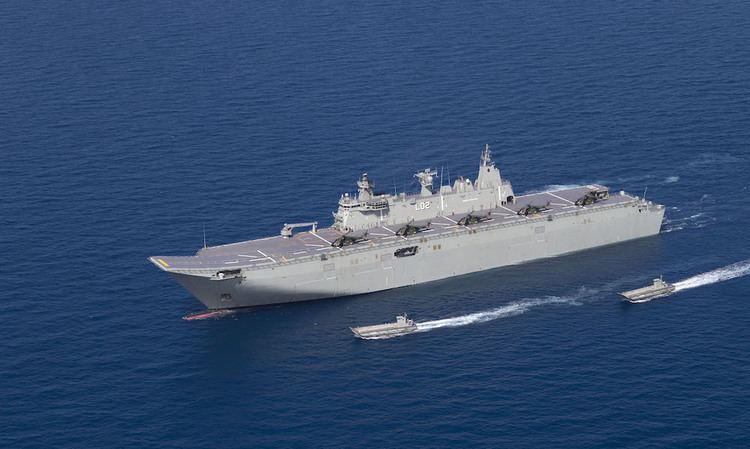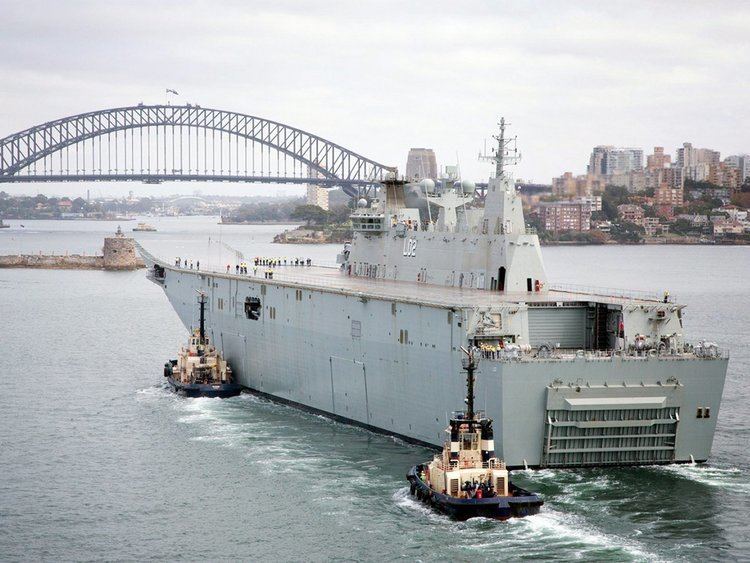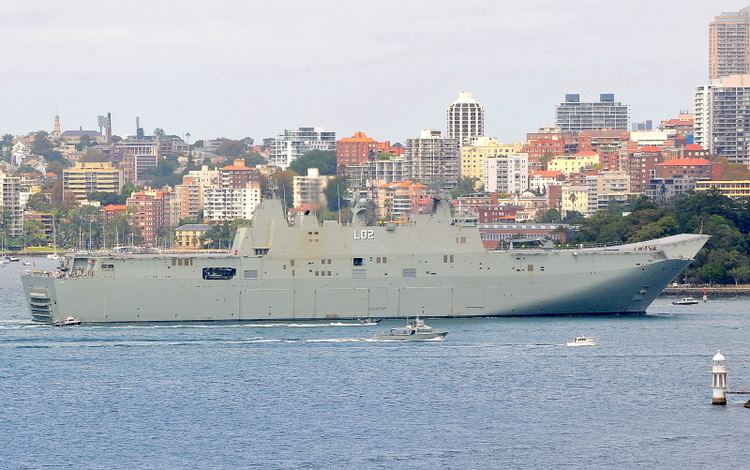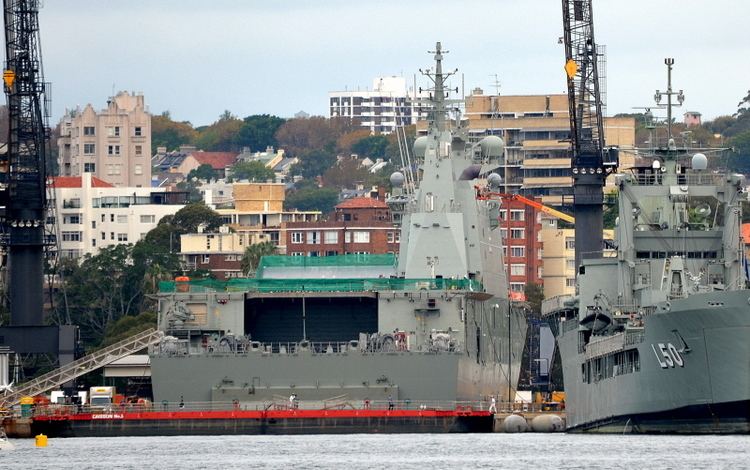Commissioned 28 November 2014 Motto For Queen and Country Construction started 23 September 2009 Beam 32 m | Laid down 23 September 2009 Length 231 m Launched 17 February 2011 | |
 | ||
Honours andawards Battle honours five inherited battle honours | ||
HMAS Canberra (L02) is the first of two Canberra-class landing helicopter dock (LHD) ships constructed for the Royal Australian Navy (RAN). Construction of the ship started in Spain in 2008, with the hull launched by Navantia in 2011. The hull was then transported to Australia in late 2012 for completion by BAE Systems Australia. Canberra was commissioned on 28 November 2014.
Contents

Design

The Canberra class design is based on the warship Juan Carlos I, built by Navantia for the Spanish Navy. The contract was awarded to Navantia and Australian company Tenix Defence following a request for tender which ran from February 2004 to June 2007, beating the enlarged Mistral class design offered by French company Direction des Constructions Navales. Canberra has the same physical dimensions as Juan Carlos I, but differs in the design of the island superstructure and the internal layout, in order to meet Australian conditions and requirements. Unlike the Spanish vessel, the Australian ships are built to meet Lloyd's Naval Rules.
The Canberra-class vessels are 230.82 metres (757.3 ft) long overall, with a maximum beam of 32 metres (105 ft), and a maximum draught of 7.08 metres (23.2 ft). At full load, Canberra will displace 27,500 tonnes (27,100 long tons; 30,300 short tons), making her the largest vessel to serve in the RAN. Propulsion is provided by two Siemens 11-megawatt (15,000 hp) azimuth thrusters, each with an onboard electric motor, driving two 4.5-metre (15 ft) diameter propellers. The electricity is provided by a Combined diesel electric and gas system, with a single General Electric CM2500 gas turbine producing 19,160 kilowatts (25,690 hp), supported by two MAN 16V32/40 diesel generators, each providing 7,448 kilowatts (9,988 hp). Maximum speed is over 20 knots (37 km/h; 23 mph), with a maximum sustainable full-load speed of 19 knots (35 km/h; 22 mph), and an economical cruising speed of 15 knots (28 km/h; 17 mph). Economical range is 9,000 nautical miles (17,000 km; 10,000 mi).

Each ship is fitted with a Saab 9LV Mark 4 combat management system. The sensor suite includes a Sea Giraffe 3D surveillance radar, and a Vampir NG infrared search and track system. For self-defence, the LHDs will be fitted with four Rafael Typhoon 25 mm remote weapons systems (one in each corner of the flight deck), six 12.7 mm machine guns, an AN/SLQ-25 Nixie towed torpedo decoy, and a Nulka missile decoy. Defence against aircraft and larger targets is to be provided by escort vessels and air support from the Royal Australian Air Force (RAAF). The ships' companies will consist of 358 personnel; 293 RAN, 62 Australian Army, and 3 RAAF.

The LHDs will transport 1,046 soldiers and their equipment. Canberra will be capable of deploying a reinforced company of up to 220 soldiers at a time by airlift. Two vehicle decks (one for light vehicles, the other for heavy vehicles and tanks) have areas of 1,880 square metres (20,200 sq ft) and 1,410 square metres (15,200 sq ft) respectively, and between them can accommodate up to 110 vehicles. The well deck will carry up to four LHD Landing Craft (LLC), which can be launched and recovered in conditions up to Sea State 4. The flight deck can operate six MRH-90-size helicopters or four Chinook-size helicopters simultaneously, in conditions up to Sea State 5. A mix of MRH-90 transport helicopters and S-70B Seahawk anti-submarine helicopters will be carried: up to eight can be stored in the hangar deck, and the light vehicle deck can be repurposed to fit another ten. The ski-jump ramp of Juan Carlos I has been retained for the RAN ships, although fixed-wing flight operations are not planned for the ships.
Construction

Construction of Canberra began in September 2008, when the first steel was cut. The first three of 104 hull 'blocks' were laid down by Navantia at Ferrol in northern Spain on 23 September 2010. The hull was launched on 17 February 2011 by Vicki Coates, the widow of Rear Admiral Nigel Coates, a former commanding officer of the previous HMAS Canberra.
After the completion of the hull up to the level of the flight deck, Canberra was transported to Williamstown, Victoria. Canberra's hull was floated onto the heavy lift ship MV Blue Marlin on 4 August 2012, with Blue Marlin departing on 17 August. The heavy lift ship sailed via the Cape of Good Hope to avoid the risk of the ship and her cargo being hijacked by Somali pirates. The decision to avoid the shorter route via the Suez Canal and Horn of Africa was made because other options to protect Blue Marlin and Canberra were unworkable: the frigate Anzac could not be diverted from anti-piracy duties in the region to provide a dedicated escort, and Dutch authorities objected to the presence of armed military or security personnel aboard the Dutch-flagged heavy lift ship. Canberra and Blue Marlin arrived in Port Phillip on 17 October. At Williamstown, the installation of Canberra's island superstructure and the internal fitout of the hull was completed by BAE Systems Australia (which acquired Tenix in mid 2008).
The ship was officially christened on 15 February 2013. BAE continued to build the vessel in Williamstown, Victoria integrating C3 and sensors to the ship's superstructures. Canberra commenced sea trials on 3 March 2014, sailing under power for the first time. The trials program included a visit to Fleet Base East in Sydney for drydocking tests, before returning to Williamstown for communications and weapons testing. The first phase of the trials resulted in vibration damage to decking when the thruster pods were run independently at high speed (instead of in tandem, as designed), and a melted circuit breaker board when primary and emergency power systems were activated simultaneously, along with the discovery of a crack in the hull from the delivery voyage, and excessively corroded propeller nuts. The second phase of contractor-run sea trials began in July, after repairs were made, and had concluded by early September.
Canberra was handed over by BAE Systems to the Defence Materiel Organisation on 9 October 2014. The ship was commissioned on 28 November 2014 at Fleet Base East. Although identified as "LHD01" during construction, Canberra received the pennant number "L02" on commissioning; the pennant number corresponding to that used by the frigate of the same name.
Operational history
Canberra was the centrepiece of Australia Day celebrations in Sydney on 26 January 2015. In March 2015, the ship was designated the flagship of the RAN.
In February 2016, the ship was deployed from Fleet Base East initially to Brisbane in Queensland where it loaded a Royal Australian Army Engineer squadron and equipment including beach landing capabilities, water purification equipment and other essential engineering stores and then it sailed to Fiji on its first humanitarian mission after a tropical cyclone hit the country on February 20. The LHD was carrying 50 tonnes of humanitarian supplies including food, water, and medical equipment as well as more than 850 personnel from the Australian Defence Force. Embarked with the ship were three MRH-90 helicopters to support Australian operations. The Canberra joined other ADF assets to help with relief efforts.
Canberra formed part of the Australian force which participated in the RIMPAC 2016 exercise off Hawaii during mid-2016. During this deployment she successfully completed flight trials with United States military Sikorsky CH-53E Super Stallion and Bell Boeing V-22 Osprey aircraft.
